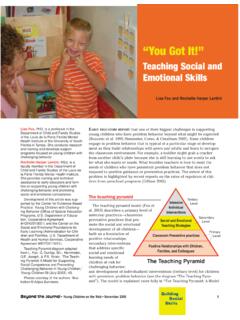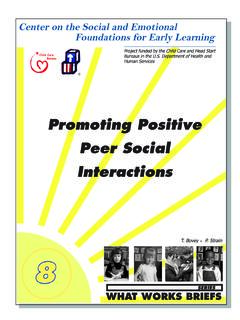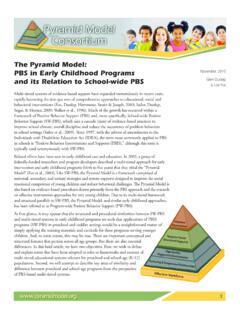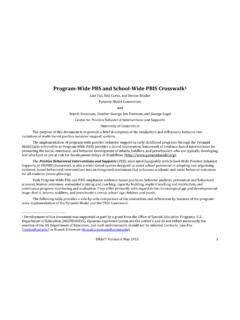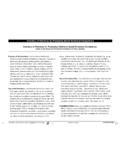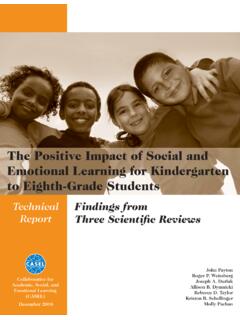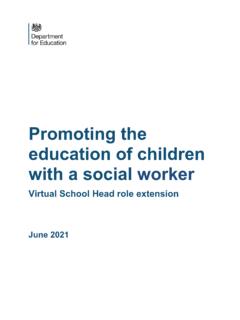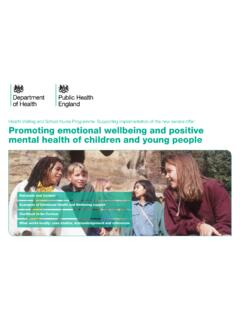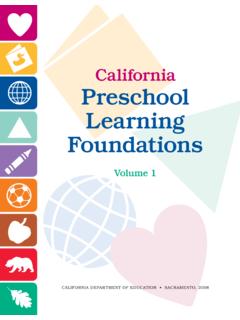Transcription of Building Positive Teacher-Child Relationships
1 Center on the social and EmotionalFoundations for Early LearningBuilding PositiveTeacher-ChildRelationshipsProjec t funded by the child Care and Head StartBureaus in the Department of Health andHuman ServicesWHAT WORKS Ostrosky JungWhile busy greeting children and preparing for the day,the teachers heard Alan, a 4-year boy, crying in thehallway. Every morning, Alan cried very loudly and refusedto come into the classroom from the bus. Mrs. Hannon, thelead teacher , found herself becoming very frustrated withAlan, and she told him to come to the classroom withoutasking why he was upset. During circle time, Alan repeat-edly kicked his feet on the carpet and did not pay attentionas Mrs. Hannon read a story to the group. Mrs. Hannontold Alan to stop kicking, but he continued kicking his feet inthe air. Exasperated, Mrs. Hannon snapped at Alan, Stopkicking, I have had enough. You are going to leave circletime.
2 Go over there and sit on the chair. I am going to tellyour mom about this. As Alan moved to the thinking chair,he began to cry. He was very mad at Mrs. Hannon andwished someone would snuggle him instead of yell What Works Brief is part of a continuing seriesof short, easy-to-read, how to informationpackets on a variety of evidence-based practices,strategies, and intervention procedures. The Briefsare designed to help teachers, parents, and othercaregivers support young children s social andemotional development. They include examples andvignettes that illustrate how practical strategiesmight be used in a variety of early childhoodsettings and home developing Positive Teacher-Child Relationships , it is importantto remember to:9 Engage in one-to-one interactions with children9 Get on the child s level for face-to-face interactions9 Use a pleasant, calm voice and simple language9 Provide warm, responsive physical contact9 Follow the child s lead and interest during play9 Help children understand classroom expectations9 Redirect children when they engage in challengingbehavior9 Listen to children and encourage them to listen toothers9 Acknowledge children for their accomplishments andeffortGiven the above information, if we revisit our hypotheticalearly childhood classroom, we might observe the followingscenario:What Are Positive teacher -ChildRelationships?
3 In early childhood settings, each moment that teachers andchildren interact with one another is an opportunity to developpositive Relationships . Teachers can use a variety of strategies tobuild Positive Relationships with children. teacher behaviorssuch as listening to children, making eye contact with them, andengaging in many one-to-one, face-to-face interactions withyoung children promote secure Teacher-Child to children using pleasant, calm voices and simplelanguage, and greeting children warmly when they arrive in theclassroom with their parents or from the buses help establishsecure Relationships between teachers and Positive Teacher-Child RelationshipsIt is important for teachers to use developmentallyand individually appropriate strategies that take intoconsideration children s differing needs, interests,styles, and through warm, responsive, physical contact such as givingpats on the back, hugging, and holding young children in theirlaps.
4 For preschool children, teachers encourage mutual respectbetween children and adults by waiting until children finishasking questions before answering them, and by encouragingchildren to listen when others speak. In addition, teachers use ofpositive guidance techniques ( , modeling and encouragingappropriate behavior, redirecting children to more acceptableactivities, setting clear limits) helps children develop trustingrelationships with their is important for teachers to use developmentally and individu-ally appropriate strategies that take into consideration children sdiffering needs, interests, styles, and abilities. For example, withinfants and toddlers, teachers respond to their cries or othersigns of distress. Teachers let children know they care aboutIn early childhood settings, each moment that teachersand children interact with one another is anopportunity to develop Positive center time, Mrs.
5 Hannon heard Alan crying, whileshe was helping another child with an art project. , realizing that she was again feeling very frustratedwith Alan, decided that she needed to develop some newchallenging behaviors and higher levels of competence Are the Children Who HaveParticipated in Research on Teacher-Child Relationships ?Research on Teacher-Child Relationships has been conductedwith children from culturally diverse families in child caresettings, university preschools, family child care settings,Head Start programs, and kindergarten classrooms. Partici-pants have included children from European American,African American, Hispanic, and Asian American , no studies indicated whether children with disabili-ties were included. When developing Relationships withyoung children, teachers should pay attention to the cultural,linguistic, and individual needs of the children. The impor-tance of adapting strategies to meet the unique needs of thechildren and families in a teacher s care cannot be Hannon heard Alan coming toward the classroom,she went out into the hallway and bent down to his level,greeting him warmly and smiling at him.
6 As Alan enteredthe classroom holding Mrs. Hannon s hand, he did not cry;he even smiled. During circle time, Alan listened to read The Very Quiet Cricket, and he respondedwhen she had the class rub their wings together byflapping their arms up and down in response to the book srepeated phrase Nothing happened, not a sound. At theend of the day as she considered all that had happened,Mrs. Hannon was pleased with how well the day went forAlan. She decided to look for resources on developingpositive Relationships with young children. She found thataffectionate behaviors (such as smiles, pats, and hugs), acalm voice, and truly listening to young children help buildpositive Relationships between teachers and children. Sherealized that she was often so busy managing the group ofchildren that she missed the individual interactions withthem. The next day, when Mrs. Hannon saw her studentscoming down the hall to enter her classroom, she stoppedtalking with her assistant teacher so she could greet eachchild with a warm smile and welcome.
7 During circle time,instead of giving attention to children who were notlistening, Mrs. Hannon praised children who were listen-ing and engaged in story time. Also, when Ms. Gloria, theteaching assistant, did some finger plays with the children,Mrs. Hannon sat next to Alan. After the finger plays, gave Alan a high five and told him what a greatjob he did following along with the finger plays. The tonein the classroom felt more Positive , and Mrs. Hannon feltshe was using her energy to help children become engagedin classroom activities and enjoy their time in the class-room rather than using her energy to constantly nag andattend to challenging when interacting with him. The next day, whenWhy Are Positive teacher -ChildRelationships Important?Research has suggested that Teacher-Child Relationships play asignificant role in influencing young children s social andemotional development.
8 In studies of Teacher-Child Relationships ,children who had a secure relationship with their preschool andkindergarten teachers demonstrated good peer interactions andpositive Relationships with teachers and peers in elementaryschool. On the other hand, children who had insecure relation-ships with teachers had more difficulty interacting with peersand engaged in more conflict with their teachers. In addition,research has shown that teachers interaction styles with childrenhelp children build Positive and emotionally secure relationshipswith adults. For instance, teachers smiling behaviors, affection-ate words, and appropriate physical contact help promotechildren s Positive responses toward teachers. Also, childrenwhose teachers showed warmth and respect toward them ( ,teachers who listened when children talked to them, made eyecontact, treated children fairly) developed Positive and compe-tent peer Relationships .
9 Moreover, children who had securerelationships with their teachers demonstrated lower levels ofResearch has suggested that teacher -childrelationships play a significant role in influencingyoung children s social and emotional Do I Find More Information onImplementing This Practice?See the CSEFEL Web site ( ) for information on Teacher-Child relationship can be foundin journals such as Young Children. See the following articlesand books for examples of how to develop Positive Teacher-Child Relationships :Bredekamp, S., & Copple, C. (Eds.). (1997). Developmentallyappropriate practice in early childhood programs (Reved.). Washington, DC: National Association for theEducation of Young on the social and emotional Foundations for EarlyLearning. (2003). promoting the social - emotional compe-tence of children. Training modules [Online]. Champaign,IL: Author. Available: [2003, August 12].
10 Elicker, J., & Fortner-Wood, C. (1995). Adult- child relationshipsin early childhood programs. Young Children, 51(1), , S., Howes, C., Shinn, M., & Galinsky, E. (1995).Quality in family child care and relative care. New York:Teachers College , S., & Wilcox-Herzog, A. (1997). Teachers interactionswith children: Why are they so important? Young Children,52(2), , B., & Saracho, O. N. (1994). Right from the start: Teaching children ages three to eight. Needham Heights, MA: Allyn & on the social and emotional Foundations for Early welcome your feedback on this What Works Brief. Please go to the CSEFEL Web site( ) or call us at (217) 333-4123 to offer material was developed by the Center on the social and emotional Foundations for Early Learning with federal funds from the Department of Healthand Human Services, Administration for Children and Families (Cooperative Agreement N.)
